Apple's 2010 MacBook Air (11 & 13 inch) Thoroughly Reviewed
by Anand Lal Shimpi on October 26, 2010 10:08 PM EST- Posted in
- Mac
- Apple
- MacBook Air
- Laptops
The 13
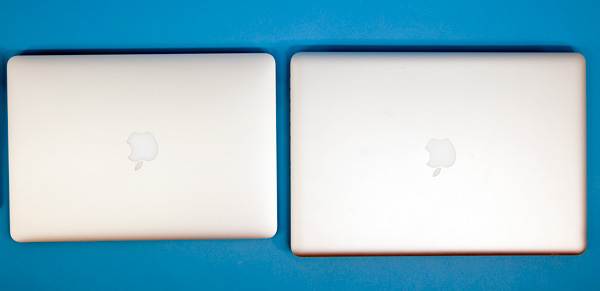
13-inch MacBook Air (left) vs. 15-inch MacBook Pro (right)
The 13-inch MacBook Air feels more like a regular notebook. It’s like one of those cartoons where you see the character straight on and he looks normal sized, but turn him 90 degrees and he’s pencil thin. When viewed from above you’d think you had a 13-inch MacBook Pro on your desktop. Its footprint isn’t that different:

But pick it up and you’re dealing with a much thinner notebook. Like the 11-inch MBA, the 13-inch model ranges from 0.11 inches to 0.68 inches in thickness. You get the same angular ID from the 11-inch model, just on a bigger scale.

13-inch MacBook Air (left) vs. 15-inch MacBook Pro (right)
The underlying hardware is unchanged, although you do get a noticeably quicker CPU. While the 11-inch model ships with a 1.4GHz Core 2 Duo (3MB L2 cache, 800MHz FSB), the 13-inch model comes with a 1.86GHz part by default (6MB L2 cache, 1066MHz FSB). I call it a noticeably quicker CPU because it is noticeably quicker, even in typical day to day use.
The 13.3-inch diagonal screen features a 1440 x 900 display (16:10 ratio). That’s the same screen resolution as the 15-inch MacBook Pro but in a smaller package. And it really makes a big difference when it comes to getting work done on the MacBook Air. This is a big improvement over the limited 1280 x 800 found in the previous two MacBook Airs and a high enough resolution to actually get work done on.
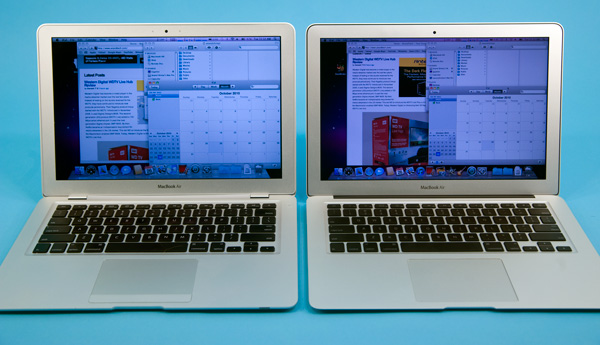
The old 13-inch MacBook Air (left) vs. the new 13-inch MacBook Air (right)
I’d go as far as to say that Apple could’ve bumped pixel density even further and the 13-inch MacBook Air would still be useable.
The 13-inch screen is a bit brighter and has a slightly better contrast ratio than the 11-inch, but it’s not something you’ll notice in use. The same vertical viewing angle limitations apply here. Unlike the 11-inch model however, you’re more likely to notice them because of the size of the display. On a plane when the passenger in front of you leans back all the way you’re probably going to have to angle the 13-inch display, while the 11-inch model may give you enough room to clear.
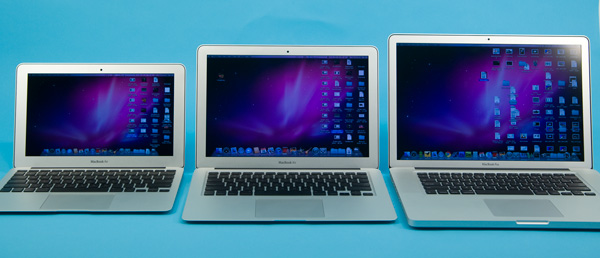
From left to right: 11-inch MBA, 13-inch MBA, 15-inch MBP
The trackpad on the 13-inch model is a taller rectangle, identical in size to what you’d find on a MacBook Pro. The wrist rest area is also normal-sized. In fact, other than the thickness there’s very little that separates the 13-inch MacBook Air from a 13-inch MacBook Pro.
Apple integrated an SD card reader with the 13-inch MBA which further identifies its light workhorse nature. It’s a nice addition that does make the MacBook Air more useful if you have a camera that uses SD cards (*grumbles at the D700*). The rest of the ports are unfortunately just as limited as the 11-inch model, but if you really want an Ethernet port you can either go the USB route or you can get a MacBook.
The stereo speakers are an improvement over the original MacBook Air. The old mono speaker was horrible to listen to. Now you've got two of them, which somehow makes the sound better. This isn’t exactly a set of Klipsch drivers but you get far less of a laughable sound out of them than before
The keyboard is identically sized to the 11-inch. You get larger function keys but there’s still no backlight. The backlit keyboard continues to be the biggest miss from the old MacBook Air.
Apple calls the new MacBook Air the future of the MacBook. If we take that literally it could mean that all future MacBooks will be the Air. Pro users will simply buy the bigger machines if they need the added performance, but the majority of users could get by with the Air. I tend to agree with this philosophy. There’s really no reason to get the base MacBook. The 13-inch MBA sacrifices a bit of performance and expansion, but you get a far more portable machine. For users who need the performance, there's always the Pro line.


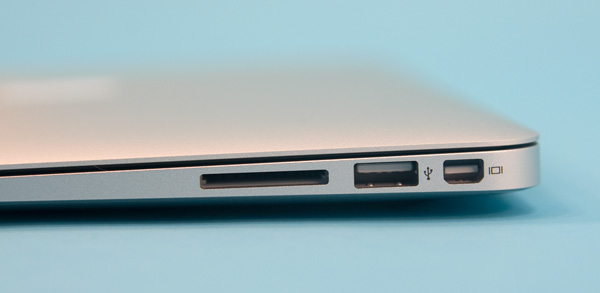
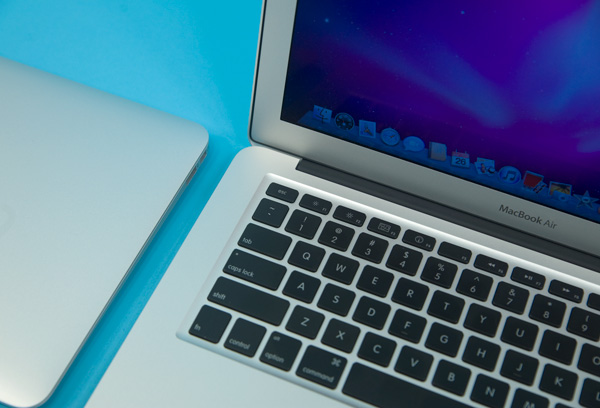








185 Comments
View All Comments
nvidia2008 - Wednesday, October 27, 2010 - link
Great article, just one niggle, Instant On does not refer to Boot, nor Wake From Sleep.From the Apple website:
"And when you put MacBook Air to sleep for more than an hour, it enters what’s called standby mode. So you can come back to MacBook Air a day, a week - even up to an entire month later - and it wakes in an instant."
http://www.apple.com/macbookair/design.html
Instant On refers to a Standby Mode (basically hibernate) that is not Boot nor Wake From Sleep.
AMDJunkie - Wednesday, October 27, 2010 - link
This is a good point; Macs with hard drives have "deep sleep" standby, which is the typical, "Hey, your battery is about to die so we're taking the system state from RAM to the hard drive" hibernation. This is an SSD, though, so I presume it writes it to the SSD after an hour, instead of after your battery dips under 5%, to help you save battery.nvidia2008 - Wednesday, October 27, 2010 - link
Yeah, I think Deep Sleep is the most closely related thing to Instant On, not Boot or Wake From Sleep. Cheershechacker1 - Wednesday, October 27, 2010 - link
OS-X, when put to sleep by closing the lid, will write out the necessary parts of memory to the hard drive.Then if your battery dies, the hibernate state resumes when you plug it back in.
If you have a ton of applications open and are using a lot of ram before closing the lid, it does take noticeably longer to actually begin sleep and turn off the HD, as indicated by the light on the macbook.
tipoo - Wednesday, October 27, 2010 - link
Yeah, Instant On is really just fast-wake-from-hibernate.Tuntavern - Wednesday, October 27, 2010 - link
Now there ARE two.ginny - Wednesday, October 27, 2010 - link
HiYou had said that your macbook air was using about 1.4 gb of memory when diting a handful of imgs in Photoshop. Do you think then that it isnt the best machine to get if I anticipate in using Adobe CS frequently? Do you think i should opt for a MBP instead? Or will upgrading the CPU and Memory suffice?
Thanks!
zhill - Wednesday, October 27, 2010 - link
Good review. I was waiting for you guys to review the new airs, good data. FYI, your images comparing the 13" MBA's size appear to be labeled incorrectly. I think the image (http://images.anandtech.com/reviews/mac/macbookair... is comparing the MBA 13" to the MBP 15" rather than the MBP 13".I'm also surprised that the screens had such a limited color gamut, I expected something in the 70% range rather than 40% but I suppose they trade that for energy efficiency(?).
I would be very curious to see your benchmarks include a new air with the 2.13GHz C2D and 4GB RAM to compare that to the the 1.86Ghz. I seem to recall that the last generation 2.13Ghz Air had even more thermal throttling issues than the lower spec chip so I wonder if it has been addressed in that configuration as well.
Any ideas on how they achieved such a fast wake time compared with the MBP 15" w/SSD? Typically, a sleep/wake operation is not very dependent upon the disk as the memory is kept powered so the system state should easily be restored without much disk access. Interesting stuff.
dsee15 - Wednesday, October 27, 2010 - link
Great Review, thank you!How much faster do you think the 13 MBA with 2.1Ghz proc, 4GB Mem, 256GB SSD would be over the stock model you tested? Do you think the faster proc will generate too much heat and initiate the governor?
How would this 'tricked out' system run VMware/windows/office?
Lastly, it appears the tricked out version could out perform both the 13 MB aluminum with hard drive and 13 MBP with hard dive, except for the most cpu intensive apps, agree...??? Could it replace a 15 MBP with hard drive?
doubledown21 - Wednesday, October 27, 2010 - link
Will there be any updates to the benchmarks if/when the 2.13GHz MBA is tested?